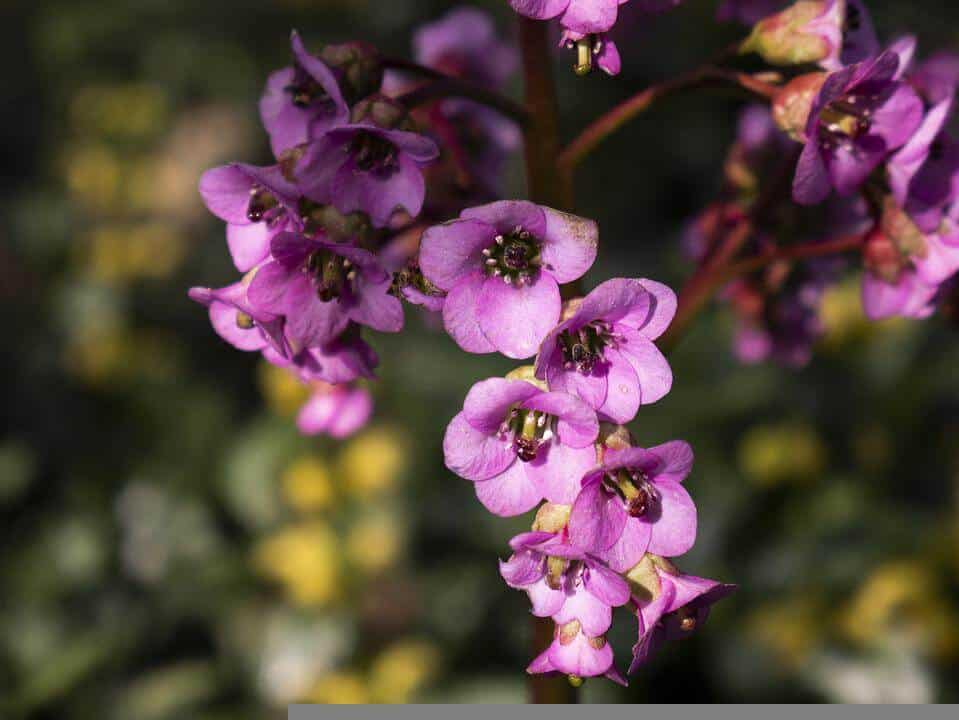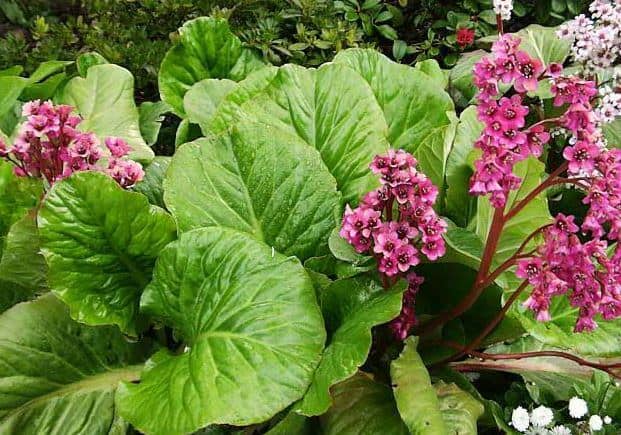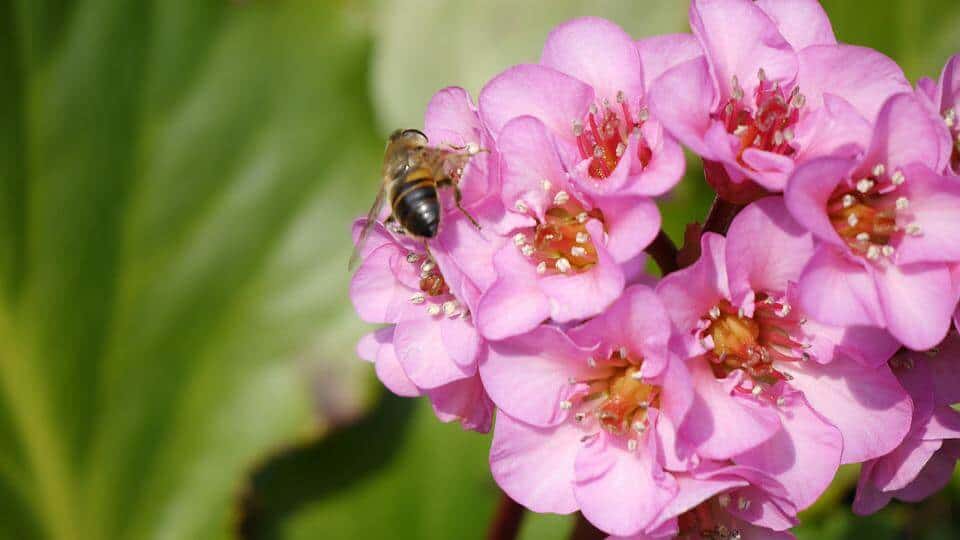Last Updated on January 11, 2023 by a Friendly Gardener
If you are looking for an excellent front-of-the-border plant that could add beauty and elegance to your backyard, Bergenia cordifolia would be a great option to consider. These bell-shaped flowers and their glossy leaves would be a great addition to your backyard.
Commonly known as ‘pig-squeak’ and ‘elephant ears’, the leaves of Bergenia cordifolia ‘winter glow’ looks evergreen in mild climates but turn into a reddish-bronze hue during the months of winter and fall.
These plants are usually tiny with their short stems and pretty pinkish flowers. Bergenias would look great if they are planted in groups or used as bordering plants for a walkway.
How to Grow Bergenia in Your Backyard

Growing bergenias requires very less maintenance and they grow well when planted in well-drained soil with a fair amount of sunlight and shade. Let’s have a look at the various aspects of this gorgeous plant which blooms in spring.
While planting bergenia in your backyard, make sure that you dig a large hole to hold its root bulbs, the hole dug should be bigger than its roots. Water immediately after planting. The leaves of the bergenia ‘winter glow’ will grow strong, attractive, and large if you mulch it for at least a year using good manure or compost.
Once your bergenias have grown, you can propagate them easily by cutting up their rhizomes. Make sure to remove their woody center before cutting apart the rhizomes after leaving at least a leaf attached to them.
You can have new bergenias by planting these rhizomes. Bergenias are known to attain maturity after two to five years of planting them.
Growing Bergenia Cordifolia from Seeds

If you wish to fill your backyard or walkway with bergenia plants, you can make use of their seeds to fulfill this purpose. You’ll need all the standard seed-starting equipment for growing bergenia indoors such as a seed-starting mix, heat mats, seed-starting trays, compost, etc.
As bergenia seeds require plenty of light for their germination to happen, make certain that you don’t cover them. You just need to press down the seeds into the soil and keep it under a bright light.
Put heat mats under the seed-starting tray as bergenias require a warm temperature for germination to happen, ideally in the range of 70 to 75 degrees Fahrenheit. Water the tray to keep the soil moist, but don’t overwater as it might damage the seeds. The germination process may take four to six weeks to happen.
Plant the bergenia seedlings in your backyard after they’ve germinated and after ensuring that the frost has passed. Plant the seedlings in the soil after leaving a gap of at least 15 inches in between the seedlings.
Bergenia Cordifolia Care

Bergenias don’t require constant attention to bloom and grow, as long as they are planted in the right conditions. They’ll make an excellent ground cover for your garden and could even tolerate harsh growth conditions at times.
If you want to enhance their looks, take some time to remove the dead leaves, and don’t forget to deadhead the withering flowers.
Soil
Though bergenias can tolerate harsh growth conditions, they grow and bloom the best when planted in aerated loamy soils.
Light
Bergenias can thrive in both sunlight and shade. They do not require heavy sunlight to bloom and it is one of those plants that can grow well even in heavy shade.
Water
Bergenias grow well in moist soil but are also capable of tolerating drought conditions.
Fertilizers
You don’t need to use fertilizer to aid the blooms in a bergenia as compost and loamy soil would do the trick.
Temperature
Many varieties of bergenias can handle extreme temperatures from -35 degrees to 115 degrees Fahrenheit. They are known for their ability to withstand long durations of cold temperatures.
But they would need some light to grow and bloom well. There could be some sort of damage during extreme cold climates as well.
Different Bergenia Varieties

Following are the varieties of Bergenia cordifolia that are much preferred by gardening enthusiasts.
Bergenia Cordifolia Winter Glow
Bergenia ‘winter glow’ is known for its heart-shaped glossy foliage and the reddish-bronze color its leaves turn into during fall. They have pink blooms, red stems, and thick leaves.
Bergenia Cordifolia Bressingham White
Bergenia Bressingham white has gorgeous bell-shaped white flowers and its leaves change their color from bright green to a burgundy-bronze color during fall. They require little care and would thrive both in shade and sun.
Bergenia Cordifolia Angel Kiss
Bergenia angel kiss is a tiny plant that blooms white flowers that slowly turns into pink as time passes. Their green leaves turn into a reddish color during winter.
Bergenia Cordifolia Ballawley
Bergenia ballawley grows up to 24 inches in height and has a width of around 18 inches, making it one of the largest bergenia varieties that are known. They have red stems and crimson-red blooms.
Bergenia Cordifolia Solar Flare
Bergenia solar flare is known for its variegated leathery leaves of yellow and cream. They have small stems and the variegated effect becomes prominent during cold months. They have beautiful magenta-purple flowers that bloom in spring.
Uses of Bergenia Cordifolia
Bergenias are much sought after as fresh-cut flowers and for their use in wreaths and other flower arrangements. You can grow these plants as a ground cover or pave the walkways or as a front-of-the-border plant. The glossy leaves of bergenias that change color in fall is also used in flower arrangements because of their beauty.
Apart from their aesthetic uses, Bergenia has been traditionally used as a medicine in different cultures across the world to treat ailments like headaches, fevers, colds, etc.
Parting Thoughts
Bergenia cordifolia with blooms that come in different hues of pink, magenta, white, orange, etc., would be a great addition to your garden as they require less maintenance to grow and could tolerate extreme cold conditions very well.
Bergenias are usually not troubled by insects or plant diseases, and deers and rabbits also avoid it. If you are looking for a plant that is easy to maintain and survives well in hot or cold temperatures, Bergenia cordifolia is the one for you.

